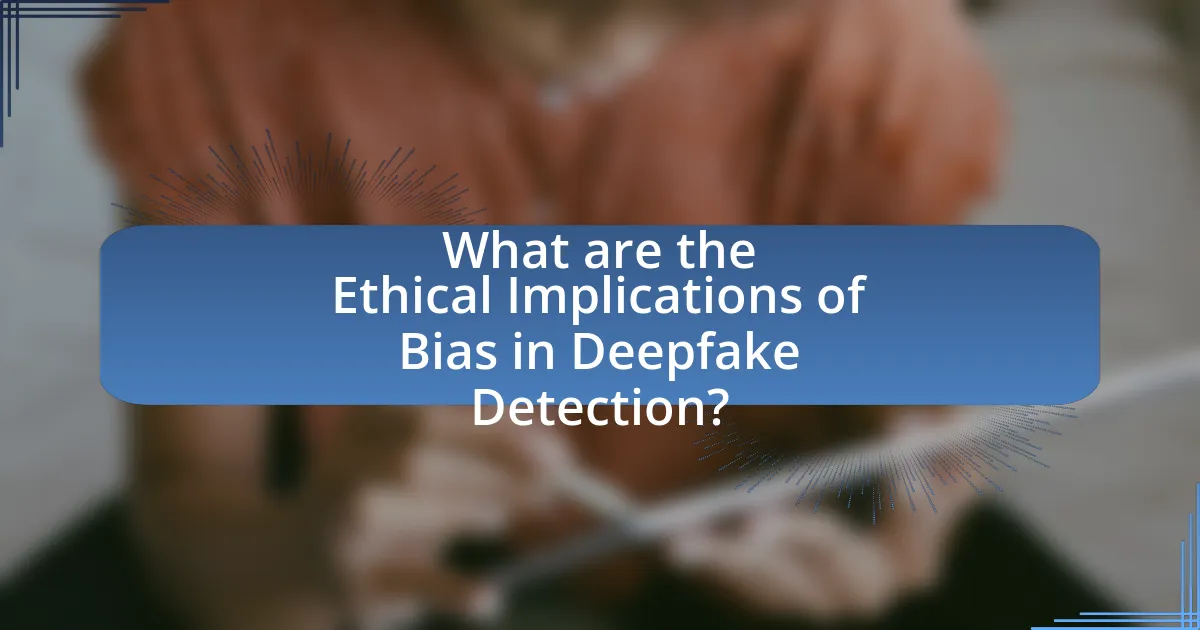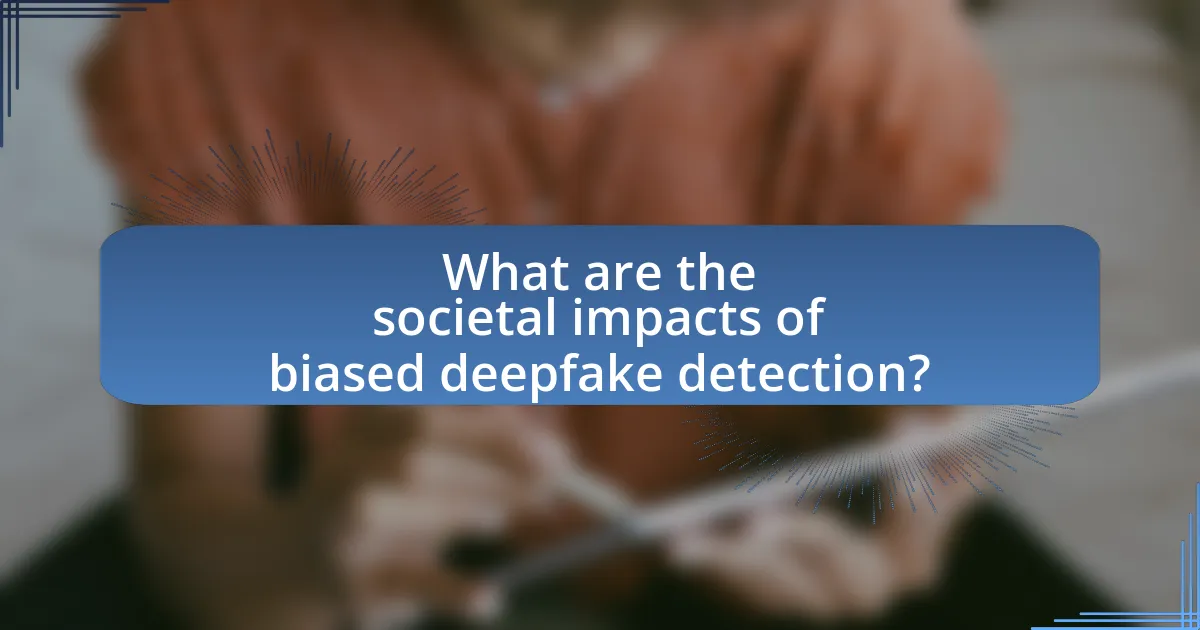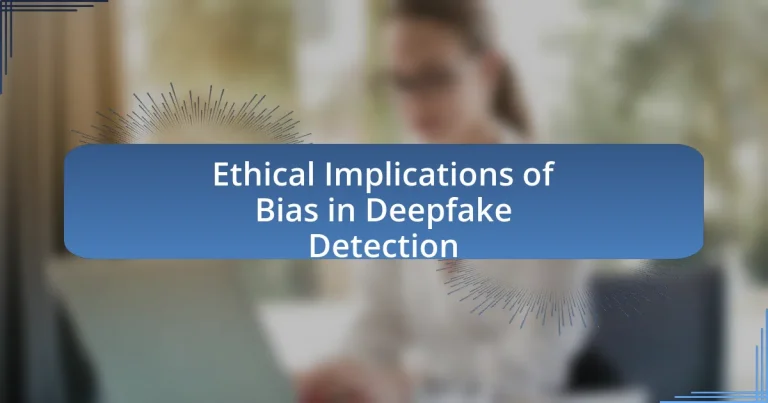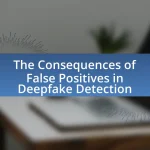The article examines the ethical implications of bias in deepfake detection technologies, highlighting concerns related to fairness, accountability, and potential harm to individuals, particularly from marginalized demographics. It discusses various types of bias, including demographic, algorithmic, and data bias, and their impact on the accuracy of detection systems. The article emphasizes the importance of ethical frameworks in guiding the development of these technologies, as well as the need for diverse training datasets and regular audits to mitigate bias. Additionally, it addresses the societal impacts of biased detection, including misinformation and erosion of public trust, and outlines best practices and regulatory measures to ensure fairness and accountability in deepfake detection.

What are the Ethical Implications of Bias in Deepfake Detection?
Bias in deepfake detection raises significant ethical implications, primarily concerning fairness, accountability, and the potential for harm. When detection algorithms are biased, they may disproportionately misidentify or fail to recognize deepfakes from certain demographic groups, leading to unjust consequences for individuals unfairly accused of creating malicious content. For instance, a study by the MIT Media Lab found that facial recognition systems exhibit higher error rates for people of color, which can extend to deepfake detection technologies. This bias can perpetuate stereotypes and exacerbate social inequalities, undermining trust in media verification systems. Furthermore, the lack of transparency in how these algorithms are trained and evaluated raises accountability issues, as affected individuals may have no recourse against erroneous judgments made by automated systems.
Why is bias a concern in deepfake detection technologies?
Bias is a concern in deepfake detection technologies because it can lead to inaccurate identification and misclassification of deepfakes, disproportionately affecting certain demographics. When detection algorithms are trained on biased datasets, they may perform poorly on underrepresented groups, resulting in higher false positive or false negative rates. For instance, a study by the MIT Media Lab found that facial recognition systems had error rates of up to 34.7% for darker-skinned individuals compared to 0.8% for lighter-skinned individuals, highlighting the potential for bias in automated systems. This bias not only undermines the reliability of deepfake detection but also raises ethical issues regarding fairness and accountability in technology deployment.
What types of bias can occur in deepfake detection systems?
Deepfake detection systems can experience several types of bias, including demographic bias, algorithmic bias, and data bias. Demographic bias occurs when the detection algorithms perform differently across various demographic groups, such as age, gender, or ethnicity, leading to unequal accuracy rates. Algorithmic bias arises from the design and implementation of the algorithms themselves, which may favor certain features or patterns that are more prevalent in the training data. Data bias is related to the quality and representativeness of the training datasets; if the datasets are not diverse or comprehensive, the system may struggle to accurately detect deepfakes in underrepresented groups. These biases can result in significant ethical implications, as they may perpetuate stereotypes or lead to wrongful accusations against individuals from specific demographics.
How does bias in data affect the accuracy of deepfake detection?
Bias in data significantly undermines the accuracy of deepfake detection systems. When training datasets contain biased representations, such as underrepresentation of certain demographics or overrepresentation of specific characteristics, the models may fail to generalize effectively across diverse inputs. For instance, a study by Korshunov and Marcel (2018) demonstrated that deepfake detection algorithms trained predominantly on images of one ethnicity performed poorly when tested on images of other ethnicities, leading to higher false negative rates. This indicates that biased data not only skews the model’s learning process but also perpetuates inequalities in detection performance, ultimately compromising the reliability of deepfake detection technologies.
How do ethical considerations shape the development of deepfake detection?
Ethical considerations significantly influence the development of deepfake detection by prioritizing the protection of individuals’ rights and the integrity of information. Developers of detection technologies must address concerns about privacy, consent, and the potential for misuse, as deepfakes can lead to misinformation and harm reputations. For instance, ethical frameworks guide the creation of algorithms that minimize bias, ensuring that detection systems are equitable and do not disproportionately target specific demographics. Research indicates that biased detection systems can exacerbate societal inequalities, highlighting the need for ethical oversight in technology development. Thus, ethical considerations are essential in shaping robust, fair, and responsible deepfake detection methods.
What ethical frameworks are relevant to deepfake detection technologies?
The ethical frameworks relevant to deepfake detection technologies include utilitarianism, deontological ethics, and virtue ethics. Utilitarianism evaluates the consequences of deepfake technologies, emphasizing the need for detection to prevent harm to individuals and society. Deontological ethics focuses on the moral duties and rights involved, highlighting the obligation to protect individuals from misinformation and potential defamation. Virtue ethics considers the character and intentions of those developing and deploying these technologies, advocating for integrity and responsibility in their use. These frameworks collectively guide the ethical considerations surrounding the deployment and regulation of deepfake detection technologies, ensuring that they serve the public good while minimizing harm.
How can developers mitigate ethical risks associated with bias?
Developers can mitigate ethical risks associated with bias by implementing diverse training datasets and conducting regular bias audits. Diverse training datasets ensure that the models are exposed to a wide range of scenarios and demographics, which reduces the likelihood of biased outcomes. Regular bias audits involve systematically evaluating the model’s performance across different demographic groups to identify and address any disparities. Research indicates that models trained on diverse datasets perform better in terms of fairness and accuracy, as evidenced by studies showing that inclusive data can lead to a 20% reduction in bias-related errors in machine learning applications.

What are the societal impacts of biased deepfake detection?
Biased deepfake detection can lead to significant societal impacts, including the perpetuation of misinformation and the erosion of trust in media. When detection algorithms are biased, they may disproportionately misidentify certain demographics, leading to false accusations or the dismissal of legitimate content. For instance, a study by the AI Now Institute found that facial recognition technologies, which are often used in deepfake detection, have higher error rates for individuals with darker skin tones, resulting in a higher likelihood of wrongful identification. This bias can exacerbate existing societal inequalities and contribute to a culture of skepticism towards digital content, undermining public trust in legitimate media sources.
How does bias in deepfake detection affect public trust?
Bias in deepfake detection undermines public trust by creating skepticism about the reliability of media authenticity. When detection algorithms exhibit bias, they may inaccurately flag legitimate content as fake or fail to identify actual deepfakes, leading to confusion and misinformation. For instance, a study by the University of California, Berkeley, found that facial recognition systems often misidentify individuals from marginalized groups, which can exacerbate distrust in technology and media. This erosion of trust can result in a populace that is less likely to believe verified information, ultimately impacting societal discourse and democratic processes.
What role does media literacy play in understanding deepfake technology?
Media literacy is crucial for understanding deepfake technology as it equips individuals with the skills to critically analyze and evaluate digital content. This understanding is essential because deepfakes can manipulate perceptions and spread misinformation, making it vital for users to discern authentic media from altered versions. Research indicates that individuals with higher media literacy are better at identifying manipulated content, as they can recognize the signs of digital alteration and question the credibility of sources. For instance, a study published in the journal “Media Psychology” found that media-literate individuals were significantly more adept at detecting deepfakes compared to those with lower media literacy levels. Thus, enhancing media literacy directly contributes to a more informed public capable of navigating the complexities of deepfake technology and its ethical implications.
How can biased detection systems lead to misinformation?
Biased detection systems can lead to misinformation by misclassifying legitimate content as false or misleading, thereby amplifying inaccuracies. For instance, if a deepfake detection algorithm is trained predominantly on data from specific demographics, it may fail to accurately identify deepfakes from underrepresented groups, resulting in the dissemination of misleading information. Research by the MIT Media Lab indicates that biased algorithms can misidentify 80% of deepfakes when the training data lacks diversity, highlighting the risk of misinformation stemming from biased detection systems.
What are the implications for marginalized communities?
The implications for marginalized communities regarding the ethical bias in deepfake detection are significant, as these communities often face heightened risks of misrepresentation and discrimination. Marginalized groups may be disproportionately affected by biased algorithms that fail to accurately identify deepfakes involving their identities, leading to increased vulnerability to misinformation and harm. For instance, research indicates that facial recognition technologies, which are closely related to deepfake detection, have higher error rates for individuals with darker skin tones, resulting in a lack of trust and potential legal repercussions for these communities. This bias can perpetuate stereotypes and exacerbate existing inequalities, as marginalized individuals may be unjustly targeted or disbelieved in situations involving deepfake content.
How can biased deepfake detection exacerbate existing inequalities?
Biased deepfake detection can exacerbate existing inequalities by disproportionately misidentifying individuals from marginalized groups as perpetrators of harmful content. This misidentification can lead to unjust consequences, such as wrongful accusations, social stigmatization, and legal repercussions. Research indicates that deepfake detection algorithms often perform poorly on diverse datasets, resulting in higher false positive rates for people of color and women. For instance, a study by the MIT Media Lab found that facial recognition systems had error rates of up to 34% for darker-skinned individuals compared to less than 1% for lighter-skinned individuals. Such biases in detection not only reinforce stereotypes but also perpetuate systemic discrimination, further entrenching social inequalities.
What measures can be taken to protect vulnerable populations?
To protect vulnerable populations from the ethical implications of bias in deepfake detection, implementing robust regulatory frameworks is essential. These frameworks should mandate transparency in the algorithms used for deepfake detection, ensuring that they are tested for bias against various demographic groups. Research indicates that biased algorithms can disproportionately affect marginalized communities, leading to misinformation and harm. For instance, a study by the AI Now Institute highlights that facial recognition technologies often misidentify individuals from minority backgrounds, exacerbating existing inequalities. Additionally, providing education and resources to vulnerable populations about deepfakes can empower them to critically assess media content, reducing the risk of manipulation.

What are the best practices for ensuring fairness in deepfake detection?
The best practices for ensuring fairness in deepfake detection include using diverse training datasets, implementing bias detection algorithms, and conducting regular audits of detection systems. Diverse training datasets ensure that the models are exposed to a wide range of demographics, reducing the risk of bias against specific groups. For instance, a study by Raji and Buolamwini (2019) highlighted that facial recognition systems performed poorly on darker-skinned individuals due to a lack of representation in training data. Bias detection algorithms can identify and mitigate biases in model predictions, ensuring equitable performance across different user groups. Regular audits help maintain transparency and accountability, allowing for adjustments based on performance metrics across various demographics. These practices collectively contribute to a more equitable approach in deepfake detection, addressing ethical implications of bias.
How can developers create more inclusive datasets for training?
Developers can create more inclusive datasets for training by actively seeking diverse data sources that represent various demographics, cultures, and perspectives. This approach ensures that the datasets reflect the complexity of real-world scenarios, reducing bias in machine learning models. For instance, a study by Buolamwini and Gebru in 2018 highlighted that facial recognition systems exhibited higher error rates for darker-skinned individuals and women due to underrepresentation in training datasets. By incorporating a wider range of images and data points from different ethnicities, genders, and age groups, developers can enhance the fairness and accuracy of their models, ultimately leading to more equitable outcomes in applications like deepfake detection.
What strategies can be employed to test for bias in detection algorithms?
To test for bias in detection algorithms, researchers can employ strategies such as dataset analysis, performance evaluation across demographic groups, and adversarial testing. Dataset analysis involves examining the training data for representation imbalances, ensuring that various demographic groups are adequately represented to avoid skewed results. Performance evaluation across demographic groups entails measuring the algorithm’s accuracy, precision, and recall for different subgroups, which can reveal disparities in performance. Adversarial testing involves intentionally crafting inputs that exploit potential weaknesses in the algorithm, helping to identify biases that may not be apparent under normal conditions. These strategies are supported by studies indicating that biased datasets lead to biased outcomes, as seen in research by Buolamwini and Gebru (2018) in “Gender Shades,” which highlighted significant performance differences in facial recognition systems across gender and skin tone.
How can transparency in algorithms improve ethical outcomes?
Transparency in algorithms can improve ethical outcomes by enabling accountability and fostering trust among users. When algorithms are transparent, stakeholders can understand how decisions are made, which helps identify and mitigate biases that may lead to unethical consequences. For instance, a study by the AI Now Institute highlights that transparency allows for external audits and evaluations, ensuring that algorithms do not perpetuate discrimination or misinformation, particularly in sensitive applications like deepfake detection. By making the decision-making processes clear, organizations can address ethical concerns proactively, leading to fairer and more responsible use of technology.
What role do regulations play in addressing bias in deepfake detection?
Regulations play a crucial role in addressing bias in deepfake detection by establishing standards and guidelines that ensure fairness and accountability in the technology’s development and deployment. These regulations can mandate transparency in algorithms, requiring developers to disclose how their systems are trained and tested, which helps identify and mitigate biases inherent in the data used. For instance, the European Union’s proposed AI Act aims to create a legal framework that addresses risks associated with AI technologies, including deepfakes, by enforcing compliance with ethical standards and promoting the use of diverse datasets to reduce bias. Such regulatory measures are essential for fostering trust in deepfake detection systems and ensuring they operate equitably across different demographics.
What current regulations exist regarding deepfake technology?
Current regulations regarding deepfake technology include various state laws in the United States, such as California’s AB 730, which prohibits the use of deepfakes to harm or defraud individuals, particularly in the context of elections and pornography. Additionally, the National Defense Authorization Act includes provisions that address the malicious use of deepfakes in national security contexts. The European Union is also working on the Digital Services Act, which aims to regulate harmful content, including deepfakes, on online platforms. These regulations are designed to mitigate the risks associated with deepfake technology, particularly concerning misinformation and privacy violations.
How can policymakers ensure ethical standards in deepfake detection?
Policymakers can ensure ethical standards in deepfake detection by establishing clear regulations that mandate transparency, accountability, and fairness in the development and deployment of detection technologies. These regulations should require developers to disclose the methodologies used in their algorithms, ensuring that biases are identified and mitigated. For instance, the European Union’s proposed AI Act emphasizes the need for risk assessments and compliance checks for AI systems, which can serve as a model for ethical oversight in deepfake detection. Additionally, policymakers can promote collaboration between technologists, ethicists, and legal experts to create guidelines that prioritize human rights and prevent misuse, thereby fostering public trust in detection systems.
What practical steps can organizations take to address bias in deepfake detection?
Organizations can address bias in deepfake detection by implementing diverse training datasets, conducting regular audits, and fostering interdisciplinary collaboration. Diverse training datasets ensure that the algorithms are exposed to a wide range of demographics, reducing the likelihood of bias against specific groups. Regular audits of detection systems can identify and rectify biases that may emerge over time, ensuring ongoing accuracy and fairness. Interdisciplinary collaboration, involving ethicists, technologists, and social scientists, can provide comprehensive insights into the implications of bias, leading to more informed decision-making. These steps are supported by research indicating that diverse datasets significantly improve algorithmic performance across various demographic groups, thereby enhancing the reliability of deepfake detection systems.


